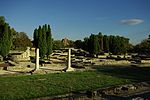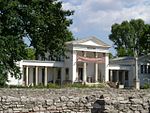Óbuda Jewish Cemetery

The Jewish Cemetery of Óbuda in Budapest, Hungary, was opened by the Jewish community in 1922 in the Óbuda-Békásmegyer district (District III) of Budapest. The opening speech was delivered by Ignác Schreiber, a young rabbi, who died only three days later, becoming the first person to be buried there.Later the remains of Mózes Müncz, Gyula Wellesz and Gyula Klein, chief rabbis of Óbuda, were brought there. The tomb of Mózes Müncz is a significant place of pilgrimage. Renowned Jewish Hungarian artists and scientists are also buried here, including the writer, Andor Endre Gelléri, and the psychologist, Ferenc Mérei. The mass grave of the Maros Street Hospital's 149 victims, patients, doctors and nurses alike, who were murdered in January 1945 by the members of the Hungarian Arrow Cross Party, during the Holocaust in Hungary, are located in this cemetery.
Excerpt from the Wikipedia article Óbuda Jewish Cemetery (License: CC BY-SA 3.0, Authors, Images).Óbuda Jewish Cemetery
Bécsi út, Budapest Kaszásdűlő
Geographical coordinates (GPS) Address Nearby Places Show on map
Geographical coordinates (GPS)
| Latitude | Longitude |
|---|---|
| N 47.5717 ° | E 19.0189 ° |
Address
Bécsi út 373
1037 Budapest, Kaszásdűlő
Hungary
Open on Google Maps









